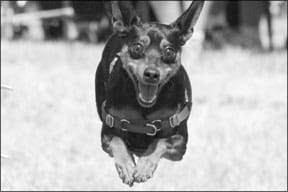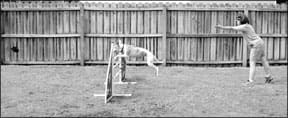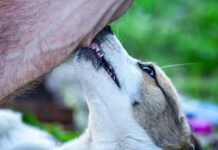[Updated February 6, 2019]
AGILITY GAMES FOR AGGRESSIVE DOGS: OVERVIEW
1. Teach your dog basic skills, such as a very quick recall and a “go” cue. That’s a bare minimum for “agility” training, even if it’s only played in your living room.
2. Keep all your practice sessions light and fun and always positive. Agility competitors have a saying, “Agility dogs don’t make mistakes; only their handlers do!”
3. Reinforce your dog’s attention and self-control as frequently and generously as possible, especially when he’s first learning these important skills.
Owning an aggressive, fearful, or other type of “special needs” dog is stressful. When your dog overreacts to other dogs or just the stimulus of being out in the world by barking, lunging, and exhibiting overexcited, out-of-control behavior, it can become so unpleasant that you start leaving him at home more and more. Of course, this coping mechanism will only contribute to your dog’s behavior issues becoming worse.
Agility may just be the thing for you! Agility is a fun dog sport that involves the dog running over planks, through tunnels, and leaping over a variety of jumps, while the nearby handler walks quickly or runs along directing his activity. In competitions, the dog being judged is the only dog in the ring, so with some self-control training and good management you may even be able to compete with your difficult dog. If that sounds like a huge leap, consider the skills your dog will acquire and benefits he will reap along the way:
Tony Rider

Increased attention is one of the many benefits resulting from agility training. If a dog is looking at you, she can’t be looking at another dog or a person at the same time. This makes attention a behavior that is beautifully incompatible with most aggressive dog behaviors.
The process of learning agility can be therapeutic for a difficult dog by building his confidence if he’s shy or fearful; many dogs who exhibit aggression are actually fearful and lacking in self-confidence.
Self-control is taught and reinforced in every phase of agility training.
Finally, because it’s fun for dogs and their people, it can help repair damage done to their relationship, and deepen the bondsbetween them.
Why Try Agility with Your Dog?
In many cases, people with difficult dogs spend most of their time trying to get their dogs not to do something don’t jump, don’t bark, don’t pull, don’t lunge. Agility gives those dogs something easy and enjoyable to do, and do with enthusiasm!
Agility is a game that you play with your dog. Play is emotionally incompatible with the emotions linked to aggression. If your dog is playful she is less likely to bark or lunge at a person or other dog.
Just as “rope courses” build confidence in people, agility course training builds confidence in dogs. At first you are certain you can’t possibly scale the wall; once you have done it you feel empowered and more confident. As dogs learn to leap over hurdles, run through tunnels, and balance over planks, their confidence increases. Since most aggression is based on fear, this increase in confidence is helpful. A more confident dog is usually a less fearful dog.
Every part of agility requires a certain amount of self-control some parts require a lot! which is always a benefit for an aggressive dog. Once a dog has learned that agility is a fun game, she will be eager to start performing the obstacles. Before she is allowed to play, however, she has to wait at the start line until her handler releases her. This is just the kind of self-control game that is beneficial to a dog with aggression issues.
Dogs also have to exhibit extraordinary self-control at an obstacle called the table. At this obstacle, the dog is asked to leap onto the table top and sit or down, holding that position for five seconds. Most dogs consider it more fun to be moving. Learning to hold still earns her the reward (positive reinforcement) of getting to continue with more running and jumping.
Agility can even help canines who don’t enjoy the company of other dogs learn to ignore them. They may even learn that dogs near agility equipment signal impending fun a little classical conditioning.
Stress and Agility
Stress is like gasoline to the fire of aggression. The movement and exercise provided in agility play are superb ways to help most dogs to de-stress.
That said, some dogs are so stressed that playing agility, especially around other dogs, is overly arousing for them. For these dogs a different game, individual (not group) classes, or maybe even a game that is played at home is more appropriate. But don’t give up on them! Find a good agility instructor to help you; cleanrun.com features a wealth of information on agility training schools.
An excellent trainer will help you determine what works best for your dog, adjusting what she teaches as you all work together. Good agility trainers do not use choke chains, prong collars, squirt guns, shock collars, or excessive crating for any reason.
Aggressive dogs can be carefully managed in an agility class (and should be, of course!). The instructor should make it very clear to the entire class that the reactive dog should not be approached by other dogs and/or people. All participants in a class that includes a reactive dog should be briefed on how to respond if there is an aggressive encounter between dogs. Also, the training area should be equipped with a “safe place” for the reactive dog and his handler to retreat to, where he can relax without having to see or deal with other dogs.
At no time should a dog who exhibits aggression be “corrected” with leash “pops” or hitting; this only confirms his bad feelings about the activity and presence of others. Instead, care should be taken to move him to a greater distance fiom the rest of the class, and more time spent working on self-control games and behaviors that are incompatible with barking and lunging. This takes time but is well worth the effort.
Therapeutic Games Useful in Agility
Even without having agility equipment, you can play the following games to help your dog learn some therapeutic skills. Be sure to play these games with a happy attitude. Dogs are truth detectors; if you fake having fun, they will know. Play with your dog only when you truly are feeling playful and want to have fun!
While you are playing, observe your dog and use her behavior as a method of feedback. If she’s playing the game slowly and methodically, bump up your own energy level to encourage her.
Eye Contact Game
This is a fun way to teach your dog to pay attention to you. With your dog on a leash, and with you standing on the end of the leash, take a piece of food in an obvious way, so she sees that you have something delicious, and hold it out at arm’s length from your head at eye level.
If she looks at your face, mark the behavior (with a click! of a clicker or verbal marker, such as the word, “Yes!”) and feed her the piece of food. Watch her carefully. Most dogs will look at the food for a few seconds, and then look at your face for clues as to why you are doing something so odd!
The second she looks at you, click! and treat. If she only stares at the food, hypnotized, hide it behind your back for a second, and then hold the food an arm’s length away from you again. Most dogs will look at you at some point when they realize that staring at the food yields nothing.
Once the dog has the idea that looking at your face earns her clicks and treats, raise the criteria slowly by requiring a slightly longer period of eye contact before she gets the click and treat. As soon as it’s clear that she gets the game, you can increase the difficulty of the exercise. Move the food closer to your head, and, as she consistently succeeds, wiggle the food around, making it progressively more challenging for her to ignore the food and make eye contact with you.
This is a very fun game that teaches self-control, eye contact, and how to ignore enticing distractions, all at the same time. These are especially valuable skills for a dog who has “issues” with people and/or dogs; you now have a behavior (eye contact with you) that is incompatible with barking and lunging. Instead of scanning the area looking for things or other beings to bark at, your dog can look at you and earn clicks and treats instead!
Restrained Recall Game
To play this game you need two people. One person holds the dog, gently restraining her from getting to the trainer. The trainer runs away from the dog calling her name. When the dog strains against the person holding her back, this person releases the dog to dash to the trainer. The trainer can then click as the dog is running to her and feed her a delicious treat or, if she is more motivated by play, play with a toy when the dog reaches her.
This game can help train your dog to come when called at light speed very helpful if you find yourself in an emergency situation with your dog off leash.
Running Side by Side Game
In this game, your dog learns to run alongside you, in a loose heeling position. The goal is for him to keep his eye on you for direction, so he doesn’t run in front and trip you! It’s easiest to start by running in a small circle, with your dog on the outside. Carry one of your dog’s favorite toys or some scrumptious treats, and click! and treat frequently at first, to engage and hold her attention. Practice in clockwise and counterclockwise circles.
Go! Game
The object of this game is to get your dog to run and jump a small obstacle on cue. This doesn’t have to be fancy; you can use a broomstick and two piles of books to make a little jump! To start, position your dog by your side, with both of you facing a small jump. You should be equipped with a toy the dog really likes, or a “bait bag” full of treats.

The idea is to throw the bag over the jump, with the intention, initially, of getting your dog to chase after it, jumping the obstacle in the process. She gets to play with the toy or enjoy a few treats before you repeat the game. After a number of successful repetitions, as she anticipates your throw and runs ahead to the jump, you can start adding a cue, such as “Go!” or “Go jump!”
As she continues to succeed and seems to enjoy this game, slowly and progressively add a little more distance until you can send your dog to the jump from 30 or more feet away. Be sure to teach your dog to play this game from both sides of your body.
Also, move the jump around and make it look different; drape a sheet over the broom, or put pillows underneath it. This will help your dog generalize the behavior, making it more likely that your dog will play the game even if the jump looks different or is in different locations.
There are Endless Agility Games to Try
It’s not immediately apparent to the casual observer, but there are literally hundreds of games that you can play with your dog in the process of teaching him to run an entire agility course. That’s a good thing for a dog who enjoys playing games! Each skill he learns can be applied in many agility activities.
Agility Teaches to Relax (Both of You!)
The benefits of agility do not end with the training session. One extremely helpful technique for modifying aggressive behavior is teaching a dog to relax. Some of the more active dogs (herding, terrier, and sporting types) can benefit tremendously by the relaxing aftereffect of exercise. After a good agility workout, most active dogs curl up for a nap.
Make it a habit to sit quietly for at least 10 to 15 minutes with your dog in a comfortable place after your agility practice session. Sit on a blanket or pad, or, if you are not at home (and if your dog is reacting to other dogs or activity nearby), sit in the back seat of the car together.
When she is sitting or lying quietly with you, reward her with treats and calm petting or massage strokes – that is, if she enjoys petting. (If she ducks your touch or becomes more energetic when you stroke her, don’t pet her during this quiet time.) Ignore her if she is active or restless. Reinforce only the desired behavior: tuning into you and calming down.
Keep yourself calm and quiet, too! Don’t “tune out” will the cell phone or by socializing with other humans. Take some deep breaths (in and out! ), relax all your muscles, and just “be” with your dog for a few minutes.
Agility is Not for Dogs in Pain
Physical issues can be a significant barrier to agility training being useful as a training or rehabilitation tool. Loose knee caps, dysplastic joints, back pain, or injuries can interfere with your dog’s enjoyment. Most agility trainers recommend a detailed veterinary physical exam of every single joint of your dog’s body prior to starting an agility training program.
Find a Positive Trainer
Agility is about bonding and connecting with your dog. It is a fun learning process for both humans and dogs. If you are in an agility class and are concerned your dog isn’t having fun, discuss this with your instructor immediately.
Any forceful training (the use of choke chains, prong collars, shock collars, water squirt guns, or excessive crating) is not part of playing the agility game. Screen instructors and schools carefully, finding a good match for yourself and your dog.
Agility is not a substitute for a behavior modification program, or medication if it is needed, but it can be a wonderful adjunct that will likely speed the progress of your dog’s path to better mental health. If you have a dog with issues, consider finding an agility clicker trainer familiar with fear, aggression, and learning theory. It will make you both feel better!
Angelica Steinker owns and operates Courteous Canine, Inc., a clicker training and agility school in Lutz, Florida. She is the author of Agility Success (2000) and Click and Play Agility (2006).






I am 2 weeks into a beginners agility group class. There are three dogs in a group of 11 that do not play well with others. 2 of the 3 owners have either dropped the leash or forcefully lost it and both of these dogs went after my dog who was behaving on leash. I am told we graduate to off-leash conditions. I am worried about the safety of my dog who is not aggressive, plays well with others, and is very obedient. Why are aggressive dogs allowed in group classes to put other dogs in danger? I think its irresponsible and careless.